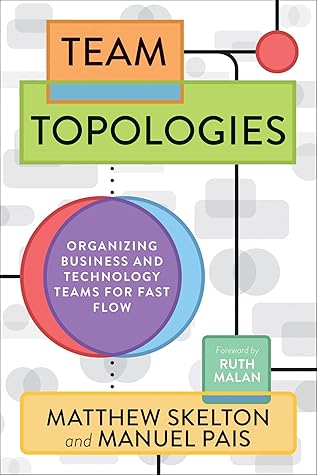More on this book
Community
Kindle Notes & Highlights
Read between
August 11 - September 26, 2023
To avoid the too-common trap of building a platform disconnected from the needs of teams, it is essential to ensure that the platform teams have a focus on user experience (UX) and particularly developer experience (DevEx).
most teams are stream aligned, with only around one in seven to one in ten teams not stream aligned.
for effective modern software development, the architecture team should support the other teams, helping them to be as effective as possible, rather than imposing designs or technology choices on other teams.
A crucial role of a part-time, architecture-focused enabling team is to discover effective APIs between teams and shape the team-to-team interactions with Conway’s law in mind.
Helping stream-aligned teams achieve this high rate of flow are enabling teams (which identify impediments and cross-team challenges, and simplify the adoption of new approaches), complicated-subsystem teams (if needed, to bring deep specialist expertise to specific parts of the system), and platform teams (which provide the underlying “substrate” on which stream-aligned teams can build and support software products and services with minimal friction).
A joined-at-the-database monolith is composed of several applications or services, all coupled to the same database schema, making them difficult to change, test, and deploy separately.
A monolithic build uses one gigantic continuous-integration (CI) build to get a new version of a component.
A monolithic model is software that attempts to force a single domain language and representation (format) across many different contexts.
A fracture plane is a natural seam in the software system that allows the system to be split easily into two or more parts.
Most of our fracture planes (software responsibility boundaries) should map to business-domain bounded contexts.
Collaboration: working closely together with another team X-as-a-Service: consuming or providing something with minimal collaboration Facilitating: helping (or being helped by) another team to clear impediments
when two teams are interacting using the collaboration mode, there should be a high value gained from working together due to the high cost of collaboration; the reward needs to be tangible.
The service they provide should be straightforward to use, test, deploy, and/or debug; and the documentation on how to use it should be clear, well-written, and up to date.
The architect should be thinking: “Which team interaction modes are appropriate for these two teams? What kind of communication do we need between these two parts of the system, between these two teams?” The architect in an organization following the Team Topologies approach is therefore the designer of team APIs that anticipate the intended software architecture.
Collaborate on potentially ambiguous interfaces until the interfaces are proven stable and functional.
Collaboration: two teams work closely together for a defined period to discover new patterns, approaches, and limitations. Responsibility is shared and boundaries blurred, but problems are solved rapidly and the organization learns quickly.
X-as-a-Service: one team consumes something (such as a service or an API) provided “as a service” from another team. Responsibilities are clearly delineated and—if the boundary is effective—the consuming team can deliver rapidly. The team providing the service seeks to make their service as easy to consume as possible.
Facilitating: one team helps another team to learn or adopt new approaches for a defined period of time. The team providing the facilitation aims to make the other team self-sufficient as soon as possible, while the team receiv...
This highlight has been truncated due to consecutive passage length restrictions.
There might be times when there is a need to colocate people—at the same desks or simply on the same floor in the same building—to produce the kind of proximity that encourages the right amount of collaboration. At other times, teams might move to separate floors or even separate buildings in order to help enforce an API boundary; a slight distance in terms of communication can help do that
collaboration often doesn’t scale across the organization; and consuming things as a service is often more effective as the number of teams increases.
Instead of trying to optimize for lowest cost in so-called “maintenance” work, it is essential that organizations use signals from maintenance work as input to software-development activities.
The team that designs and builds the software needs to be involved in its running and operational aspects in order to be able to build it effectively in the first place. The team providing this “design and run” continuity of care also needs to have some responsibility for the commercial viability of the software service; otherwise, decisions will be made in a vacuum separate from financial reality.
The reason so many organizations experience so many problems with software delivery is because most organizations have an unhelpful model of what software development is really about. An obsession with “feature delivery” ignores the human-related and team-related dynamics inherent in modern software, leading to a lack of engagement from staff, especially when the cognitive load is exceeded.
if we know we need to be able to deploy different parts of the system independently, with a short lead time, and we decide to use small, decoupled services in order to do so, we need to make our teams similarly small and decoupled, with clear boundaries of responsibility.
What does the team need in order to: Act and operate as an effective team? Own part of the software effectively? Focus on meeting the needs of users? Reduce unnecessary cognitive load? Consume and provide software and information to other teams?
technology is only ever a part of the platform; roadmaps, guided evolution, clear documentation, a concern for DevEx, and appropriate encapsulation of underlying complexity are all key parts of an effective delivery platform for stream-aligned teams.


